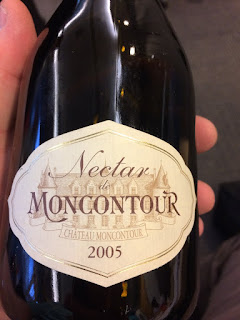After my dismal Sherry tasting - dismal because I really did not enjoy it - we had a break and then went on to try Port.
Before this class, I really didn't know the difference between Sherry and Port. It all seemed the same to me. But after this week's class, I have a better idea of the differences between these two fortified beverages. More importantly, I now know which one I like...
Port is usually made with black grapes and is alway fortified during the fermentation. Why is that important? The fortification interrupts the fermentation so there is always residual sugar left over. That means that Port is always sweet. And, it can also be really, really good!
Our first Port was a Tawny Port. Tawny Ports are a mix of red and wine Ports and are aged 10, 20, 30 or 40 years - so they are ready to drink when you buy them. The one we tried was a
Ramos Pinto 10 year old Port that cost $39 (already, you can see the price differential between Sherry and Port). It was medium tawny in colour - which is sort of a red-brown colour - the older the port, the lighter the colour. It had medium intensity and had chocolate, cherry and prune aromas on the nose. On the palate there was, in addition, plum, jam and cloves. It was off dry with medium acidity, medium body and a medium finish. I didn't write down the overall rating so, from what I remember, I would give it a Good rating.
The Sherries we tasted before the break all were given a Very Good rating by Dave but I did not like any of them. I am not a sweet wine lover but this first Port was pretty good! I quite enjoyed it and like it much more than any of the Sherries.
The second Port was even better! It was a LBV (Late Bottle Vintage) Port The Port is made from wine from the same year (in this case, 2011), and is aged 4 to 6 years in casks. It is ready to drink when you open it and sometimes has sediment so may have to be decanted. After it is opened, you should drink it like wine, because it is only good for a couple of days.
We tried a
Fonseca Port which was unfiltered (so had to be decanted). This $33 bottle had 20% alcohol - which is the same for all Ports - had medium minus intensity on the nose and had aromas of cherry, pepper and a medicinal smell. On the palate, there was black cherry, liquorice, and other black fruit. It had medium acidity, medium tannins and was off dry. I would rate this one as Good as well. A great pairing with cheese and chocolate.
The final Port was a Vintage Port - these must be decanted and are the best of the Ports. They are made from the best grapes and are only made in the best years. The one we had was a
W. and J. Graham's 2011 Vintage Port. It was deep ruby and had medium plus intensity on the nose. There were many different black fruits on the nose including black currants and black berry. On the palate there was raisin, kirsch, and a wonderful jamminess along with spices. There was a lot going on there but it was hard to pick out some of the tastes because it was rather complex. It had medium tannins and medium plus acidity and was an off dry wine with a long finish. This wine was $109 and was Very Good - maybe even Outstanding.
I never thought of myself as a Port drinker but this changed my mind. It was an amazing wine. One of my group, Rajen, said that it was either his favourite or second favourite wine that we had tasted in the course! The only problem I see is that you have to consume it in a day - that's right - a Vintage Port should be decanted for a couple of hours and then consumed on the day you open it!
We finished off with two Sweet Fortified Muscats. The first was a Vin Doux Naturel from France (naturally).
The first was a 2015
Domaine de la Pigeade Muscat de Beaumes de Venise worth $35 for a half bottle and was pale, gold and clear. It had medium intensity on the nose with perfumed aromas of apple, pear and stone fruit. On the palate, there was additionally lychee, pineapple and vanilla. It was a sweet wine with medium plus acidity, medium body and a medium finish. Dave said that this one was near the end of its life as Muscat de Beaumes de Venise should be consumed when young.
The second was a
Rutherglen Muscat (from Australia this time) and was the second sweetest wine there is, the first being PX Sherry.
Campbell's Rutherglen was $27 for a half bottle and was 17.5% alcohol. It was clear and medium amber in colour. It had medium intensity on the nose with aromas of stone fruit and tropical fruit.. On the palate, I tasted syrup - plain and simple. Being lusciously sweet, it was difficult enough to figure out what the tastes were besides syrup and sugar but this wine was über luscious! It was rated Good but I did not enjoy how syrupy sweet it was. It made my teeth hurt!
So, looking back on the class, I found that I didn't like Sherry at all, actually like Port - and loved Vintage Port, and didn't like sweet fortified Muscats all that much because they were so sweet. I know that Port is sweet, but not overly sweet and Port is sweet enough to counter the alcohol taste.
Now, back to studying - I have an exam to write next time!








































